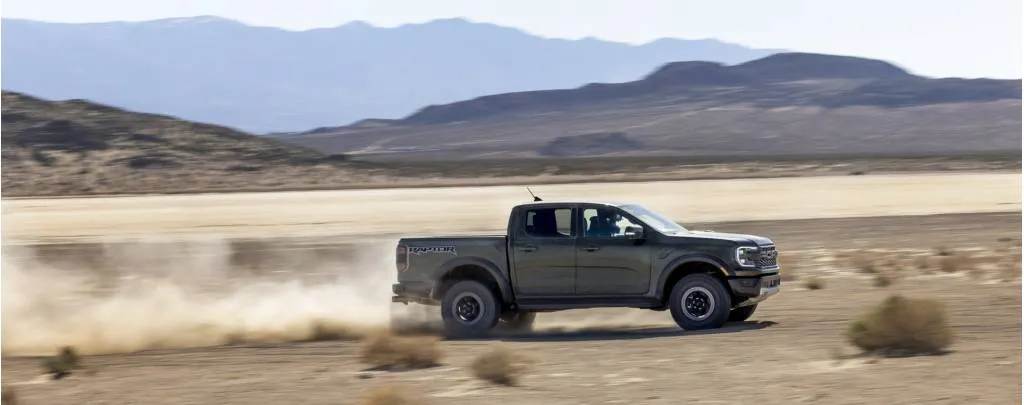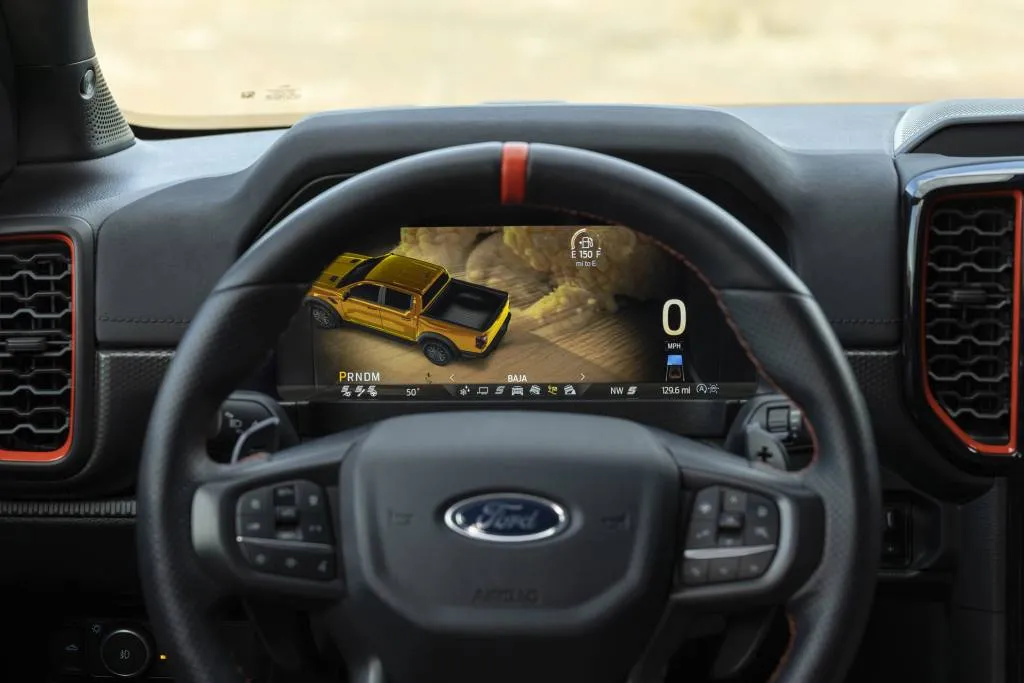The “flight attendant” stepped back with a final warning: “There will be no pedals while the Ranger Raptor is in flight.”
As instructed, I put the 2024 Ford Ranger Raptor in second gear, the throaty exhaust mumbled its discontent as the revs dropped, then I floored it between two cones at Ford’s Raptor Assault School in a nowhere valley an hour outside of Salt Lake City. We launched into mountain air.
The strange thing about going airborne on the Ranger Raptor is how normal it felt on takeoff and landing. With no reference point except watching other people go before me, I expected a shot to the back or some dental chatter. Instead, the compression and rebound of the remote reservoir 2.5-inch Fox Live Valve shocks allowed the earth to squeeze the 33-inch BFGoodrich KO2 all-terrains like grandkids’ cheeks at Christmas time. The crew cab was stable, the landing totes chill. The problem was it was over too soon.
To be fair, it was a modest table with a steep ramp but only a couple feet of drop, and I didn’t have enough runway to send it more than ten feet, maybe. Launching it in second gear ensured I wouldn’t be mid-gearshift at the launch point, causing the weight to pitch forward and nose the landing, but it also meant not tapping fully into the turbocharged 3.0-liter V-6 adopted from the Bronco Raptor. That would be for the Baja section of Assault School.


2024 Ford Ranger Raptor


2024 Ford Ranger Raptor


2024 Ford Ranger Raptor
What makes the Ford Ranger Raptor different?
The addition of the Raptor for the first time to the redesigned 2024 Ford Ranger family marks an expansion of the off-road performance arm launched in 2009, from the F-150 Raptor to the Braptor (Bronco Raptor, natch) and now, gleefully, to the Ranger. It’s king of the Ranger hill, with Lariat, XLT, and XL below it. The simple trim walk complements a simplified configuration for all models: crew cab with a 5-foot bed.
Ford says most everything is new on the Ranger, but the reskinned body sits on a familiar frame. Some crossmembers and materials have changed, but the biggest difference is Ford extended the track and the wheelbase by a couple inches over its predecessor. On the Raptor, it’s even more pronounced; the track is 3.5 inches wider than other Rangers and hung with 17-inch aluminum wheels (beadlocks are optional) wrapped with the KO2s. The fenders bulge out, then the body slims to the cab, so the bird’s-eye view of the Raptor would look like a dumbbell with a meaty handle.
Ford moved the front axle forward, but the longer wheelbase has no effect on the crew cab size. The wider track let designers expand the bed space, though. It’s now 48.2 inches wide, and can fit 4×8 sheets of plywood between the wheel wells. There are six clamps in the bed, and available LED lighting illuminates the bed and its 120-volt outlet, the better to power accessories at night. There are no swinging tricks to the tailgate, but it has a ruler built into the top, bottle openers on either side, clamp openings, and deep fender steps. The Ranger Raptor doesn’t get the fender steps.
Raptors add two tow hooks to the rear inboard of the dual tailpipes to match the hooks up front. Steel skid plates also cover the engine, transfer case, and gas tank, and all the apertures are opened in the grille, including in the giant Ford letters stamped like a 3D face tattoo.


2024 Ford Ranger Raptor
Ford Ranger Raptor performance on pavement
Even though Ford offers three turbocharged engine options across the Ranger lineup, a hybrid is not part of the powertrain plethora. The larger F-150 and smaller Maverick have hybrid options that have proven popular, but Ford’s chief U.S. engineer for the Raptor, Juan De Pena, said it wasn’t what Ranger shoppers wanted.
“A hybrid has electric and ICE (internal combustion) so you’re paying for two systems, and that’s gotta creep into price,” he told Motor Authority at the media drive program. He referred to data suggesting Ranger customers wanted power for performance more than efficiency, even though Ford reps touted that the brand sells more hybrid trucks than anyone.
That’s obviously the case with the Raptor, which uses the Braptor’s 3.0-liter turbo-V-6 tuned to 405 hp and 430 lb-ft of torque. It’s hard to pin down a 0-60 mph time, but with the 10-speed automatic standard across the lineup and the Raptor’s standard four-wheel-drive system, I’d estimate a low six-second time. The 10-speed can respond sensitively if you’re tentative with the throttle; decisive inputs result in decisive shifts. So, if you’re in a family with an on/off pedal pusher, don’t ride when they drive. Otherwise the 10-speed is smooth and predictable, and the aluminum paddle shifters give the driver more immediate control than the manual mode in the console shifter in other Rangers. Both the Lariat and the Raptor get an electronic shifter, a stubby square knob versus the meaty, old-school mechanical shifter on XL and XLT models. The shift-by-wire selector allows for more driver-assist features on the high-end models.
The changes to the track and wheelbase, as well as the tweaks to the frame, make the Ranger more road friendly than its predecessor, and that extends to the Raptor. Even on its all-terrain tires on the road to the middle of nowhere for Assault School, three adults fit comfortably and the ride was settled. The unladen bed wasn’t bouncing around like the tail wagging the dog. I’d welcome the Raptor as an everyday driver, more so than the Braptor, and the exhaust modes range from the parental to the punky.
The bed didn’t bounce in both the Ranger XLT and the Ranger Raptor, which swaps out the more tow-friendly rear leaf springs for a Watts link suspension better for high-speed off-roading.
The Raptor adds Off-Road, Baja, and Rock Crawl modes to the Normal, Sport, Slippery, and Tow Haul modes on other Rangers (the Raptor tows up to 5,510 pounds, and its payload is 1,711 pounds). The modes change the antilock braking and traction control thresholds, as well as the steering weight, and the software tweaks on the Raptor are more pronounced across the drive mode dial.
The console dial takes some getting used to: twist it to activate the drive mode menu in the Raptor’s 12.4-inch instrument cluster, then twist it again to zero in on the desired mode. The dial also doubles as the controller for Ford’s excellent Pro Trailer Backup Assist, which lets you turn the dial in the direction you want the trailer to go instead of counter-turning the steering wheel; it’s a must-have for the occasional if not insecure tow-er, especially with a small trailer.
All this adds up to a more comfortable Raptor than the Braptor and a more manageable off-roader than the F-150 Raptor. And Baja mode is a blast.


2024 Ford Ranger Raptor


2024 Ford Ranger Raptor


2024 Ford Ranger Raptor
Ford Ranger Raptor off-road awesomeness
The Raptor comes with electronic locking front and rear differentials. I followed a F-150 Raptor up and down hills strewn with rocks and bedeviled by ruts, and while it didn’t come near the rugged off-roading of the Braptor test course, the Ranger Raptor has all the tricks to negotiate strenuous off-road trials. It lacks the Braptor’s Trail Control system that brakes the inside rear wheel to make tighter turns, but Rock Crawl mode has a trail control system like an uphill or downhill cruise control that work up to 10 mph, changeable in increments of 0.5 mph. In Off-Road mode it extends the limit to 20 mph, and can be changed in 1 mph increments. In either scenario, pressing the throttle will override the system momentarily before you let off and it returns to the setting; pressing the brake cancels it.
The rain started on our way from the off-road to the Baja course, and a flick of the windshield wiper spray simultaneously cleaned the front camera because we were in Off-Road mode. There’s no way to clean it on its own, aside from the old thumb wipe, but the front camera is key for the Raptor’s standard surround-view camera system that ties into side mirror cameras and a rearview camera for 360-degree views around the truck as well as bird’s-eye views in the Raptor’s standard 12.0-inch touchscreen.


2024 Ford Ranger Raptor


2024 Ford Ranger Raptor


2024 Ford Ranger Raptor
We moseyed on over to the Baja course as the moisture muddied the dirt, as if on cue. Baja mode taps into the full power of the 3.0-liter V-6, opens up the exhaust system, and illuminates the cluster and ambient lighting. It can be activated in 2H or 4H, with the rear differential lock on or off, so owners can tap into their comfort levels in terms of rotational control. I had it in 4H with the lockers off, and the stability control setting in its least intrusive. I flung some dirt and sidewinded through the opening section before finally getting enough speed to brake hard into a banked cutback. It took a second run on the course to get it right, but feeling the rear rotate as the bulging hood reoriented forward, the rear snapping back in line in a rooster tail of mud was peak fun.
The braking hardware is the same as in other Rangers, but the software is calibrated differently so I could set the nose down right before the turn without anti-lock brake chatter interrupting my flow. The paddle shifters helped tap into the right gearing, and the suspension sorted the truck well enough to eclipse 50 mph on the final strait, with a little launch of its own into the braking area. The only problem was wanting to do it over and over again, but that joy is reserved for Ranger Raptor owners.
One day of off-roading at Ford’s Ranger Raptor Assault School in Tooele Valley, Utah, starting in June is included in the purchase of a Ranger Raptor. The course demonstrates the Raptor’s potential in someone else’s truck, instead of the one you just bought.
At $56,960, the 2024 Ford Ranger Raptor is the most accessible Raptor yet. The F-150 Raptor costs at least $20,000 more than the base Ranger, but the midsize Raptor makes for a more fun Baja package. The Ranger Raptor’s starting point is about $15,000 less than when the Braptor launched in 2022, and its subsequent popularity now has Ford charging about $92,000. The market has spoken.
Ford paid for travel and lodging for Motor Authority to toss the Ranger Raptor around a muddy off-road course.
